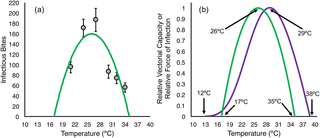当前位置:
X-MOL 学术
›
PLOS Biol.
›
论文详情
Our official English website, www.x-mol.net, welcomes your feedback! (Note: you will need to create a separate account there.)
Quantifying the effects of temperature on mosquito and parasite traits that determine the transmission potential of human malaria.
PLOS Biology ( IF 9.8 ) Pub Date : 2017-10-16 , DOI: 10.1371/journal.pbio.2003489 Lillian L M Shapiro 1 , Shelley A Whitehead 1 , Matthew B Thomas 1
PLOS Biology ( IF 9.8 ) Pub Date : 2017-10-16 , DOI: 10.1371/journal.pbio.2003489 Lillian L M Shapiro 1 , Shelley A Whitehead 1 , Matthew B Thomas 1
Affiliation

|
Malaria transmission is known to be strongly impacted by temperature. The current understanding of how temperature affects mosquito and parasite life history traits derives from a limited number of empirical studies. These studies, some dating back to the early part of last century, are often poorly controlled, have limited replication, explore a narrow range of temperatures, and use a mixture of parasite and mosquito species. Here, we use a single pairing of the Asian mosquito vector, An. stephensi and the human malaria parasite, P. falciparum to conduct a comprehensive evaluation of the thermal performance curves of a range of mosquito and parasite traits relevant to transmission. We show that biting rate, adult mortality rate, parasite development rate, and vector competence are temperature sensitive. Importantly, we find qualitative and quantitative differences to the assumed temperature-dependent relationships. To explore the overall implications of temperature for transmission, we first use a standard model of relative vectorial capacity. This approach suggests a temperature optimum for transmission of 29°C, with minimum and maximum temperatures of 12°C and 38°C, respectively. However, the robustness of the vectorial capacity approach is challenged by the fact that the empirical data violate several of the model's simplifying assumptions. Accordingly, we present an alternative model of relative force of infection that better captures the observed biology of the vector-parasite interaction. This model suggests a temperature optimum for transmission of 26°C, with a minimum and maximum of 17°C and 35°C, respectively. The differences between the models lead to potentially divergent predictions for the potential impacts of current and future climate change on malaria transmission. The study provides a framework for more detailed, system-specific studies that are essential to develop an improved understanding on the effects of temperature on malaria transmission.
中文翻译:

量化温度对决定人类疟疾传播潜力的蚊子和寄生虫性状的影响。
已知疟疾的传播受到温度的强烈影响。目前对温度如何影响蚊子和寄生虫生活史特征的了解来自有限的实证研究。这些研究可追溯到上世纪初,但往往控制不力,复制受限,探索温度范围狭窄,并使用了寄生虫和蚊子的混合物。在这里,我们使用亚洲蚊子An的单对。斯蒂芬斯和人类疟疾寄生虫恶性疟原虫对与传播有关的一系列蚊子和寄生虫性状的热性能曲线进行了综合评估。我们表明咬伤率,成人死亡率,寄生虫发育率和载体能力是温度敏感的。重要的,我们发现与假设的温度相关关系在质和量上都存在差异。为了探索温度对传输的总体影响,我们首先使用相对矢量容量的标准模型。该方法建议最适合传输温度为29°C,最低和最高温度分别为12°C和38°C。但是,经验数据违反了该模型的简化假设中的一些事实,对矢量能力方法的鲁棒性提出了挑战。因此,我们提出了一种相对感染力的替代模型,该模型可以更好地捕获所观察到的载体与寄生虫相互作用的生物学特性。该模型建议传输的最佳温度为26°C,最低和最高分别为17°C和35°C。模型之间的差异导致对当前和未来气候变化对疟疾传播的潜在影响的潜在分歧。该研究为更详细,针对特定系统的研究提供了框架,这对于增进对温度对疟疾传播的影响的了解至关重要。
更新日期:2017-10-17
中文翻译:

量化温度对决定人类疟疾传播潜力的蚊子和寄生虫性状的影响。
已知疟疾的传播受到温度的强烈影响。目前对温度如何影响蚊子和寄生虫生活史特征的了解来自有限的实证研究。这些研究可追溯到上世纪初,但往往控制不力,复制受限,探索温度范围狭窄,并使用了寄生虫和蚊子的混合物。在这里,我们使用亚洲蚊子An的单对。斯蒂芬斯和人类疟疾寄生虫恶性疟原虫对与传播有关的一系列蚊子和寄生虫性状的热性能曲线进行了综合评估。我们表明咬伤率,成人死亡率,寄生虫发育率和载体能力是温度敏感的。重要的,我们发现与假设的温度相关关系在质和量上都存在差异。为了探索温度对传输的总体影响,我们首先使用相对矢量容量的标准模型。该方法建议最适合传输温度为29°C,最低和最高温度分别为12°C和38°C。但是,经验数据违反了该模型的简化假设中的一些事实,对矢量能力方法的鲁棒性提出了挑战。因此,我们提出了一种相对感染力的替代模型,该模型可以更好地捕获所观察到的载体与寄生虫相互作用的生物学特性。该模型建议传输的最佳温度为26°C,最低和最高分别为17°C和35°C。模型之间的差异导致对当前和未来气候变化对疟疾传播的潜在影响的潜在分歧。该研究为更详细,针对特定系统的研究提供了框架,这对于增进对温度对疟疾传播的影响的了解至关重要。



























 京公网安备 11010802027423号
京公网安备 11010802027423号